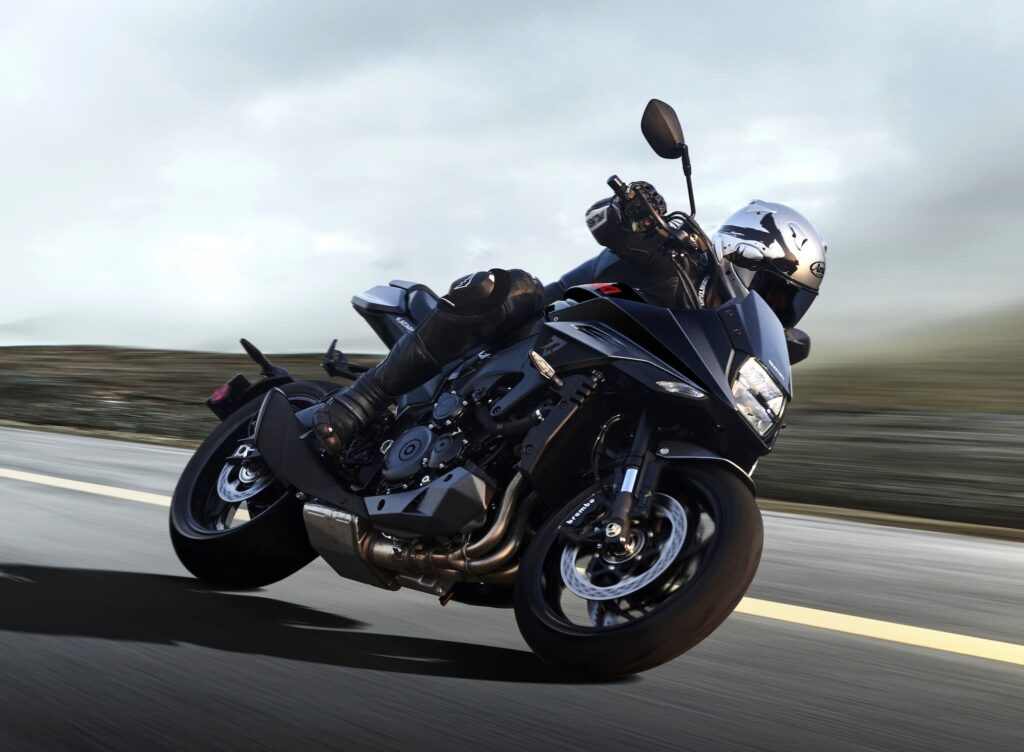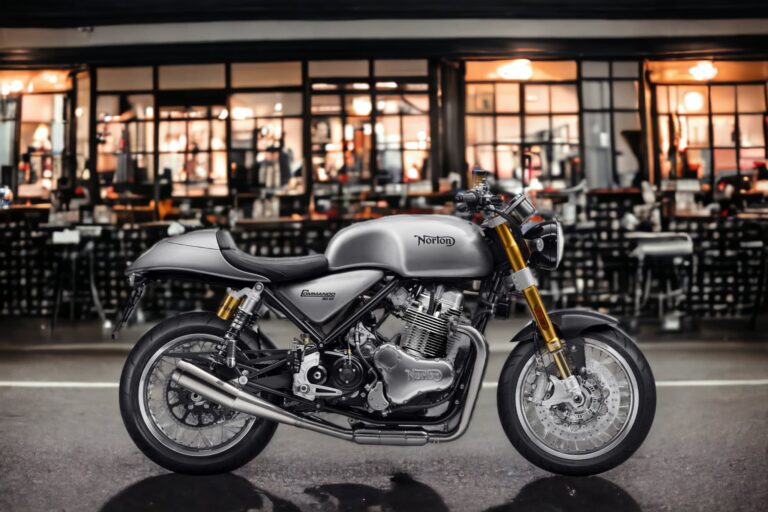Suzuki Katana 1000 (2020+) Maintenance Schedule and Service Intervals
This is the maintenance schedule and associated service intervals for the Suzuki Katana 1000 made since 2019 for the 2020 model year. It’s also known as the Suzuki GSX-S1000S Katana, but it’s mostly known as the “new” Suzuki Katana.
This maintenance schedule is very similar to that for the GSX-S1000, as it’s based on the same underlying platform.
The Suzuki Katana is a naked bike with an edgy retro design. As with its GSX-S1000 stablemate, its engine is a technologically updated block from the highly acclaimed longer-stroke 2005-2006 K5 GSX-R1000. This is a retro bike for Katana but it’s also a throwback to a very futuristically designed model which wasn’t terribly well-received at the time (but which is now a classic).
Updated in 2023 with chain maintenance guidelines.
This site has links for things like oil and spark plugs from which we earn a commission (which unfortunately nobody can save, not even us). If you appreciate this work, then please use those links. Thanks!
Suzuki Katana Service Intervals
Overall, the Suzuki Katana has 3750 mile / 6000 km service intervals. At every service, change the oil, and do a host of other checks for leaks, smooth operation, and correct lubrication.
Suzuki recommends more checks every two services, and the major valve inspection check every 15000 mi / 24000 km.
Since the Katana has a liquid-cooled engine, make sure the coolant is kept up to spec. Suzuki recommends changing the long-life coolant every four years.
Also, make sure the brake fluid is replaced regularly.
Finally, since the Suzuki Katana has a chain final drive, make sure to clean, check the condition of, and re-tension the chain regularly.
What you need to service your Suzuki Katana
Below is a list of the things you’ll need to do a service on your Suzuki Katana, aside from general standard motorcycle maintenance tools.
| Part | Suzuki Katana spec |
|---|---|
| Oil | Suzuki (like most motorcycle brands) requires engine oil with JASO MA spec, or at least API SF/SG or SH/SJ spec. Many oils fit this. Suzuki recommends SAE 10W-40 weight Suzuki motor oil, but I wouldn’t over-think this and use another popular high-grade oil like Motul 7100 10W-40. |
| Oil filter | Use a Hiflofiltro HF138RC, which is a drop-in high-quality replacement. |
| Air filter | Use a K&N air filter as a drop-in replacement, part number SU-9915. |
| Spark plugs | The standard spark plug is NGK CR9EIA9, an iridium plug. You need four. |
| Brake fluid/Clutch fluid | Suzuki (like most motorcycles) requires DOT 4 brake and clutch fluid. |
| Brake pads | Most people upgrade their brake pads to EBC ones for better performance (and they’re very affordable). Use EBC part codes FA447HH for the front (two pairs) and FA174HH for the rear (one pair). |
| Coolant | Suzuki only requires a coolant that’s “compatible with an aluminium radiator”. Most motorcycle coolants are, and so Valvoline Zerex G05 is a fine option. Honda coolant is excellent value for money. |
| Chain maintenance | Use either Motul chain paste or a complete Motul chain care kit for frequent chain servicing. |
| Grease | Always handy to have some lithium soap-based grease for external pivot points, like the kickstand. |
Suzuki Katana Maintenance Schedule
Below is the maintenance schedule for the 2020+ Suzuki Katana.
Maintaining your Suzuki Katana is much like maintaining any other big naked bike. You have a chain drive so you have to lubricate the chain, you have to change the oil and filter, and replace the fluids every 2-4 years.
NOTE:
- Observe the earlier of distance- or time-based intervals.
- I= Inspect and clean, adjust, replace or lubricate as necessary, R= Replace, T= Tighten
- Coolant — If using super long-life kind (e.g. Honda Coolant), replace every four years or 48,000 km; otherwise, replace every two years or 24,000 km.
| mi x 1000 | 0.6 | 3.75 | 7.5 | 11.25 | 15 | |
|---|---|---|---|---|---|---|
| km x 1000 | 1 | 6 | 12 | 18 | 24 | |
| months | 2 | 12 | 24 | 36 | 48 | Every |
| Engine oil (High-grade synthetic, Motul 300V) | R | R | R | R | R | |
| Engine oil filter (HF138RC) | R | – | – | R | – | |
| Air cleaner element (K&N SU-9915) | – | I | I | R | I | |
| Spark plugs (CR9EIA9) | – | I | R | I | R | |
| Valve clearances | – | – | – | – | I | |
| Exhaust pipe bolts and muffler bolts | T | – | T | – | T | |
| Exhaust control valve | I | – | I | – | I | |
| Fuel hose | – | I | I | I | I | |
| Evaporative emission control system | – | – | I | – | I | |
| Throttle cable play | I | I | I | I | I | |
| PAIR (air supply) system | – | – | I | – | I | |
| Throttle valve synchronization | – | – | I | – | I | |
| Engine coolant “Super long-life” or an alternative | – | – | – | – | R | 4 years / 29 000 mi (48 000 km) |
| Radiator hose | – | I | I | I | I | |
| Clutch cable play | – | I | I | I | I | |
| Drive Chain (Motul chain care kit) | I | I | I | I | I | Clean/Lube every 600 mi / 1000 km |
| Brakes | I | I | I | I | I | |
| Brake fluid (DOT 4 only) | – | I | I | I | I | Replace every 2 years |
| Brake hose | – | I | I | I | I | Replace every 4 years |
| Tires | – | I | I | I | I | |
| Steering | I | – | I | – | I | |
| Front forks | – | – | I | – | I | |
| Rear suspension | – | – | I | – | I | |
| Chassis bolts and nuts | T | T | T | T | T | |
| Lubrication (Lithium soap-based grease) | Lubricate every 1000 km (600 miles) |
Maintaining your Chain on your Suzuki Katana
Maintain your chain on your Katana regularly to ensure it operates safely and effectively. Either use a good-quality (and affordable) chain lube like Motul Chain Paste, or use a full on Motul Chain Care Kit to clean and restore a chain.
Suzuki recommends that you maintain your chain regularly according to the following schedule.
| Chain maintenance item | Every |
|---|---|
| Check chain * Correct tension / slack (20-30mm / 0.8-1.2 in at loosest point) * Adequate lubrication * No excessive wear / damage | Ride (pre-ride check) |
| Clean and lubricate chain | 1000 km / 600 miles |
Damage to the chain and sprockets includes loose pins, damaged rollers, dry or rusted links, kinked or binding links, excessive wear, and improper adjustment.
To adjust the chain slack on the Katana, follow the procedure below.

As with previously, make sure that the motorcycle is on a level surface on its kickstand, in neutral, with no weight on it (no saddlebags / luggage).
- Loosen the rear axle and the adjuster lock nuts on either side of the axle.
- Turn the adjuster nuts to tighten (or loosen) the chain. Keep checking the chain tension to see if it has come within spec. (Target chain slack for the Katana: 20-30 mm)
- Keep an eye on the alignment marks on either side of the axle. Make sure that the adjustment is to the same point.
- When you’re done, tighten the axle to 100 Nm / 73 lb-ft, and tighten the adjuster lock nuts.
- Re-check the chain slack again to make sure it’s still within spec.
Tire size and tire pressure for the Suzuki Katana
The manual for the Suzuki Katana specifies the following tire sizes, pressures, and suggested brands (which many are quick to replace).
| Tyre | Size | Tire pressure (cold) | Brand(s) shipped with |
|---|---|---|---|
| Front | 120/70 ZR17 58W | 36 psi/250 kPa | DUNLOP D214F M |
| Rear | 190/50ZR17 73W | 42 psi/290 kPa | DUNLOP D214 M |
About the “new” Suzuki Katana (2020+)

Like the Suzuki GSX-S1000F on which it’s based, the Suzuki Katana is powerful sport standard bike.
The Suzuki Katana takes the raw energy of the K5-8 GSX-R1000 and makes it more comfortable, adds some safety features, puts more oomph in the mid-range rather than at the top end, and gives it a lot more retro style.
The Gixxer-based engine is a long-stroke (73.4 x 59.0mm) inline four-cylinder engine. It doesn’t rev quite as high as the old GSX-R’s motor — it has stainless steel valves rather than the K5’s titanium ones, and it has revised cam timing.
Combined with lower gearing (two additional teeth on the rear socket), there’s no question that the Katana’s engine is tuned for torque. It buzzes a bit when running at speed — at 90mph (145 km/h) in top gear, you’re doing 6,000 rpm… so uh, maybe slow down a little.
The original Katana is no slouch in power figures, either. It shares the same updated engine in 2018 as its GSX-S1000F cousin, and makes 108 Nm (80 lb-ft) @ 9,500 rpm, and 113 kW (150 hp) @ 11,300 rpm.
Even though it looks a bit like a naked bike, don’t mistake the Suzuki Katana for something like a Triumph Bonneville. The seat is somewhat minimal and the bars are a little lower than what you’d get on a naked bike.
The position on the Suzuki Katana 2020 is definitely “sporty”, more like what you’d expect of a streetfighter-style bike. There’s another cue to slow down and enjoy the torque down low — there’s no wind protection.
The suspension isn’t sportbike firm, but it’s good. The Suzuki Katana has fully adjustable inverted 43mm KYB front and rear shocks, adjustable for pre-load, rebound, and damping. You can find the limits of the suspension on the track or in very aggressive street riding, but when you’re on rough surfaces, you’ll remember that this is a street bike.
Braking is also impressive for the Katana, with dual 310mm discs and Brembo monoblock 4-piston calipers.
The Suzuki Katana has not been significantly updated since launch, with mostly colors and a few new electronic features released.
The 2022+ Suzuki Katana got a few new internals to give it a slight horsepower boost as well as helping it meet Euro 5 spec. It also gets
- SDMS (Suzuki Drive Mode Selector) with three throttle maps
- A bidirectional quickshifter standard
- An improved slipper clutch
- An updated dash with a “night” mode, and
- Suzuki’s Easy Start system (that helps prevent you from stalling the bike)

Manual for the Suzuki Katana
The above maintenance schedule comes directly from the user’s manual for the 2020 Suzuki Katana. It’s the same as for other years of the Suzuki Katana.

You can download Suzuki manuals from here.













